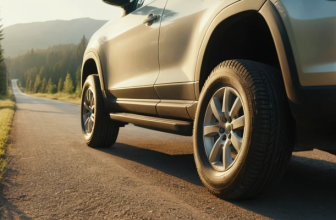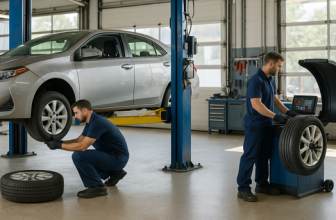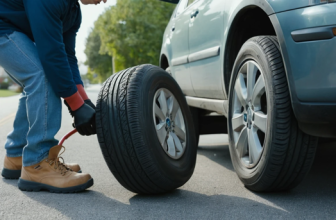Flashing tire pressure light? Learn what it means, how to fix it, and keep your ride safe with these easy expert tips.
Flashing Tire Pressure Light? Here’s What It Means 🚨
Ever seen that little tire icon blink on your dashboard? 😳 It’s annoying, but it might mean something serious. Your car’s flashing tire pressure light is a warning. Ignoring it could lead to big problems.
Let’s talk about what it means, what to do, and how to avoid bigger issues.
What Does a Flashing Tire Pressure Light Mean? ⚠️
A flashing tire pressure light usually means something’s wrong with the Tire Pressure Monitoring System (TPMS). It’s not just low pressure. It could be a sensor failure, dead battery, or a communication glitch.
Here’s what it could signal:
- One or more tires have dangerously low pressure.
- The TPMS sensor battery is dying or dead.
- A TPMS sensor is broken or lost signal.
- There’s an internal fault in the TPMS system.
So if that light’s flashing before turning solid, your car is telling you, “Hey! Something’s up with the monitoring system.”
Why the Flashing Happens, Not Just Glowing 🔄
You might think a light is a light—but flashing and solid mean two different things.
- Flashing light: The TPMS system itself has a problem.
- Solid light: Tire pressure is too low in one or more tires.
If your light flashes for 60–90 seconds when you start your car, then stays on solid—your system is saying BOTH “I’m broken” and “Your tire pressure sucks.” 😬
TPMS Basics: Know Your System 🛠️
Every car built after 2007 in the U.S. has a TPMS. It helps prevent accidents and improves fuel economy.
There are two types of TPMS:
| TPMS Type | How It Works | Pros | Cons |
|---|---|---|---|
| Direct | Uses sensors inside each tire | Accurate, fast alerts | Sensors can fail or need replacing |
| Indirect | Uses ABS wheel speed sensors | No extra hardware needed | Less accurate, needs resets |
Knowing your type helps when diagnosing problems or buying replacements.
What To Do When It Starts Flashing 🚗💨
Don’t panic. Follow these steps:
- Pull over safely. Don’t risk a blowout.
- Check your tire pressure manually. Use a pressure gauge.
- Look for obvious damage. Punctures? Sidewall bulges?
- Top off your air. Add air to the recommended PSI (check your door sticker).
- Restart your car. Light is flashing again?
- Visit a repair shop. Likely a sensor issue.
This simple list can save your tires, rims, gas money, and maybe even your life.
How To Reset the TPMS Light 🧰
Sometimes, the TPMS just needs a reboot. Here’s how:
- Drive at 50 mph for 10 minutes. This can reset some systems.
- Use the TPMS reset button. Found below the steering wheel in many models.
- Turn ignition ON, not engine. Hold the reset until it blinks 3 times.
- Reinflate and balance tires. If uneven, TPMS may stay confused.
Stil flashing? You’re probably dealing with a dead sensor or system error.
Common Causes of TPMS Failure ❌
There are several reasons your system might not be working properly:
- Sensor battery dies. Usually after 5–10 years.
- Aftermarket wheels. May not have TPMS compatibility.
- Tire rotation or change. Can confuse indirect systems.
- Corrosion on valve stems. Common in winter areas.
Stay ahead by checking these during routine tire service.
Cost to Replace a TPMS Sensor 💵
Money talk: how much will it run you?
| Component | Cost Range (Each) | Notes |
| Sensor only | $40–$100 | OEM sensors are pricier |
| Labor | $20–$75 | Per tire, depending on shop |
| Programming | Free–$50 | Some require special tools |
So yeah, it can add up. But driving with a faulty TPMS can lead to bigger costs.
Is It Safe to Drive With It Flashing? 🛑
Short answer? Not really. A flashing light means your TPMS isn’t watching your tires. That means you’re driving blind to pressure loss.
Low tire pressure can:
- Ruin your fuel economy
- Wreck your tire tread
- Cause dangerous blowouts
So it’s not worth the risk—get it fixed.
What If the Light Flashes in Cold Weather? ❄️
This happens a lot. Cold air makes tire pressure drop. Your sensors notice and panic.
Do this:
- Add air when tires are cold (morning).
- Recheck after driving.
- Keep a small portable pump handy.
This is super common, specially in northern states.
Tips To Avoid Future TPMS Issues ✅
Want to keep that light off forever? Try these:
- Check tire pressure monthly.
- Inspect valve stems.
- Replace tires in sets.
- Get sensors checked during tire service.
Prevention is always cheaper than replacement.
Can I Replace the Sensor Myself? 🧑🔧
If you’re handy, sure—but it’s not for beginners.
You’ll need:
- TPMS tool scanner
- Tire removal equipment
- New TPMS sensor (right frequency)
It’s safer and faster to let pros handle it. One mistake, and you’re out $100.
Don’t Confuse TPMS With ABS or Engine Lights 🧠
Many dashboard lights look alike. Make sure you don’t mix them up.
| Light | Meaning | Symbol |
| TPMS | Tire pressure issue | ⚠️ Circle with exclamation |
| ABS | Brake system problem | ⚙️ Circle with “ABS” |
| Check Engine | Engine fault | 🔧 Engine icon |
If you’re unsure, always check your manual.
How Long Do TPMS Sensors Last? ⏳
Most sensors last 7–10 years or 100,000 miles.
But, cold weather, rough roads, and lots of driving can wear them out faster.
So, get them checked during routine tire maintenance.
Can Low Tire Pressure Trigger the Flashing? 🧯
Yes, but usually, it just makes the light solid. If pressure stays low long enough, it might affect the sensor’s behavior and cause blinking.
Check your pressure weekly—before road trips.
What If I Just Ignore the Light? 🤷♂️
That’s a bad idea.
Ignoring it means:
- You won’t know if a tire is losing air fast.
- Fuel costs go up.
- Tire life drops drastically.
- You may fail an inspection in some states.
Just fix it—it’s usually quick and affordable.
Recap: Don’t Wait When You See the Flash 🚘
Let’s wrap it up. A flashing TPMS light means the system isn’t doing its job. That’s a big deal for your safety and wallet.
Here’s what you should remember:
- Flashing light = sensor/system issue.
- Solid light = low pressure.
- Check pressure, reset system, and fix faulty sensors.
- Don’t delay. Bad tires = bad day.
Drive smart, stay safe—and keep an eye on those tires.
FAQs 🤔
Why is my tire pressure light blinking constantly?
Your TPMS system likely has a sensor issue or communication error. Check tire pressure first, then visit a mechanic if it keeps blinking.
How can I tell if a tire pressure sensor is bad?
The light flashes every time you start your car, or it won’t turn off even after refilling. A scan tool can confirm which sensor is faulty.
Can cold weather trigger flashing tire lights?
Yes, sudden cold snaps lower tire pressure and confuse sensors. Add air when tires are cold to fix this quickly.
Is it safe to reset TPMS myself?
Yes, if you follow the steps in your manual. But if problems continue, get a pro to scan the system.
What happens if I ignore the flashing TPMS light?
You risk driving with underinflated tires and missing leaks. That can lead to tire damage, poor fuel economy, or a blowout.





